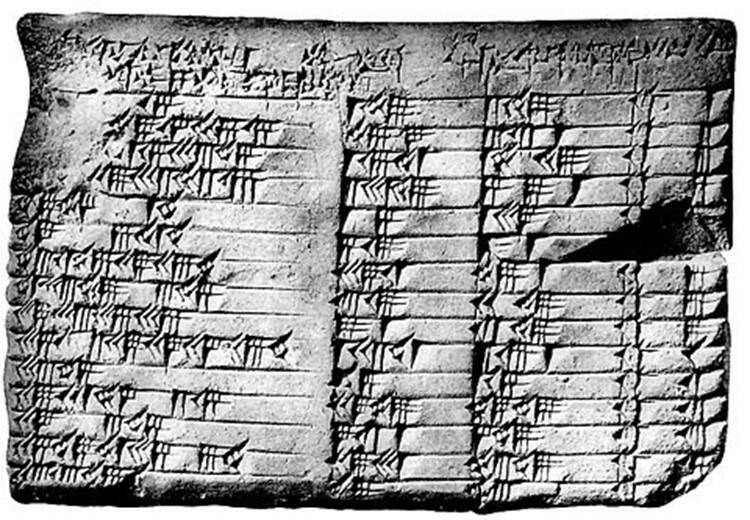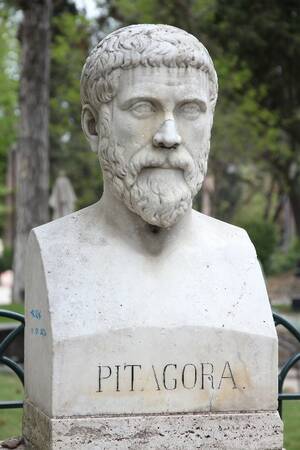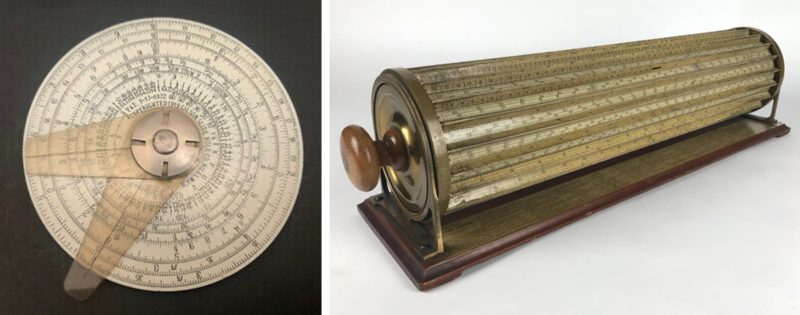It All Adds Up: A Celebration of Mathematics
Where would we be without math? (Or if you’re in the UK or Australia: maths.) April is international Mathematics and Statistics Awareness Month, and 2022 also happens to be the 400th anniversary of the slide rule—an important mathematical tool for hundreds of years before electronic calculators and computers came along in the 20th century.
A Brief History of Mathematics
The earliest evidence of mathematical methods, notation, and concepts dates back roughly 3,000 years to the ancient Mesopotamian and Sumerian civilizations. The first surviving mathematical text is a clay tablet from ancient Babylon, ca. 2000-1900 B.C. The ancient Egyptians began using arithmetic, algebra, and geometry for taxation, commerce, trade, to study astronomy, and to create calendars.

A Babylonian clay tablet called Plimpton 322 (in the G.A. Plimpton Collection at Columbia University). Believed to have been written about 1800 BC, it contains columns and rows of numbers written in cuneiform script.

The discipline of mathematics was named and advanced significantly in Greece in the 6th century B.C. led by Pythagoras (right, a sculture of Phythagoras at the Villa Borghese in Rome, Italy). He was the originator of the Pythagorean Theorem, which is familiar to every geometry student. The Greeks advanced mathematics in areas such as deductive reasoning and logical proofs. The Romans made contributions to applied mathematics, using it for surveying, structural and mechanical engineering, and bookkeeping.
Mathematical concepts also emerged in China in the 11th century with independent development of algebra, geometry, number theory, and trigonometry. The Chinese counting system included both large numbers and negative numbers and also base 2 and base 10 systems. Today we use what’s called the “Arabic” numeral system (1, 2, 3, etc.). It was first developed in India between the first and fourth centuries C.E., and then spread via Islamic mathematicians, especially the Persian al-Khwarizmi.
By the Middle Ages the standard disciplines of math were well established, and helped contribute to the flourishing of astronomy, science, and discovery that began in the Renaissance and has continued up to modern times. Today’s mathematical minds often collaborate with physicists to explore areas such as string theory, particle physics, and quantum theory. Many are focused on applied mathematics in fields such as artificial intelligence/machine learning, and mathematic & statistical modeling in the natural sciences (e.g., climate change, energy efficiency) and health sciences (e.g., the COVID-19 pandemic). A a few of them work here at Radiant.
The Story of the Slide Rule
In the early 1600’s, logarithms were first developed, with their invention attributed to two men. One is Scottish mathematician John Napier, who wanted to simplify multiplication and division calculations by substituting simpler arithmetic (addition and subtraction). He published tables of logarithms for general reference. In parallel, English mathematician and inventor Edmund Gunter created the first known logarithmic scale instrument to help seafarers with nautical calculations.
In 1632, Englishman William Oughtred built on these developments and designed the first adjustable logarithmic scale, in the shape of a circle. He also designed the first linear rule, but it wasn’t until 1654 that the now-standard linear "sliding rule" was invented by Robert Bissaker.

Vintage circular slide rule (left) and a cylindrical slide rule (right), called the Thacher, after its inventor Edwin Thacher.
In essence, slide rules are basically analog computers, providing a quick way to do calculations that would be laborious to perform using only pencil and paper. As the name suggests, a slide rule is composed of several individual rulers that can slide (or rotate) into different alignments to give the result of various calculations.
The rulers are marked with a linear or logarithmic scale (graduated markings related to exponential values), making it possible to perform rapid calculation of multiplication and division, squares and square roots, cubes and cube roots, logarithms, and trigonometry functions. Read more about the different scales that can be found on slide rules and how to apply them for a range of calculations.
To the Moon!
It’s common knowledge that the amount of computing power on a modern cell phone is more than NASA used to get its astronauts to the moon. Also worth noting is that the mathematical computations for the Apollo missions were done primarily by hand, often relying on a slide rule (in many cases, by women with the job title of “calculator” such as Katherine Johnson and her colleagues, made famous by the movie Hidden Figures).
Handheld electronic calculators weren’t invented until 1972, so slide rules were a critical tool carried by virtually every NASA engineer to perform routine calculations. In fact, astronaut Edwin “Buzz” Aldrin used his pocket slide rule during the Apollo 11 mission to do some last-minute calculations before landing on the moon. When the Apollo 13 mission went awry, engineers were able to quickly recalculate flight trajectories using their trusty slide rules. Learn more about how slide rules played a role in the space program.

NASA’s standard-issue slide rule was the 6-inch Pickett N600-ES. This one was used for the Apollo 13 moon mission. (Image source: Smithsonian National Air & Space Museum)
Applied Math is Everywhere
Every young student who ever complained about math (‘why do I need to know this? I’ll never use it in real life!’) was sadly mistaken. Because mathematics is fundamental—it’s a universal language that can describe virtually every object, action, and phenomenon around us. The fields of science and medicine all depend on statistical analysis of data. And applied mathematics isn’t just for complex topics like advanced physics, finance, and clinical research.
From carpenters measuring dimensions and angles on a construction site to shopkeepers tracking product inventory, from a home buyer comparing mortgage terms to computer programmers building a vast virtual universe out of ones and zeros, math is everywhere. You can’t even bake a cake without using weights and measures and temperature, or drive a car without considering the relationship between speed, time, and distance.
Of course, mathematics is pretty fundamental to Radiant also. We don’t use slide rules, but we do a lot of measuring and calculating. The heart of our business is capturing quantities of light and color (whether from a light source or emitted from a display screen) with our ProMetric® Imaging Photometers and Colorimeters. Our software then measures numeric values of luminance and chromaticity and performs additional analyses that manufacturers can use to assess the visual performance of their products.
To join us in the celebration of all things mathematical, visit the website of Mathematics and Statistics Awareness Month. And remember—math "counts" (sorry, we couldn't resist).

Join Mailing List
Stay up to date on our latest products, blog content, and events.
Join our Mailing List
